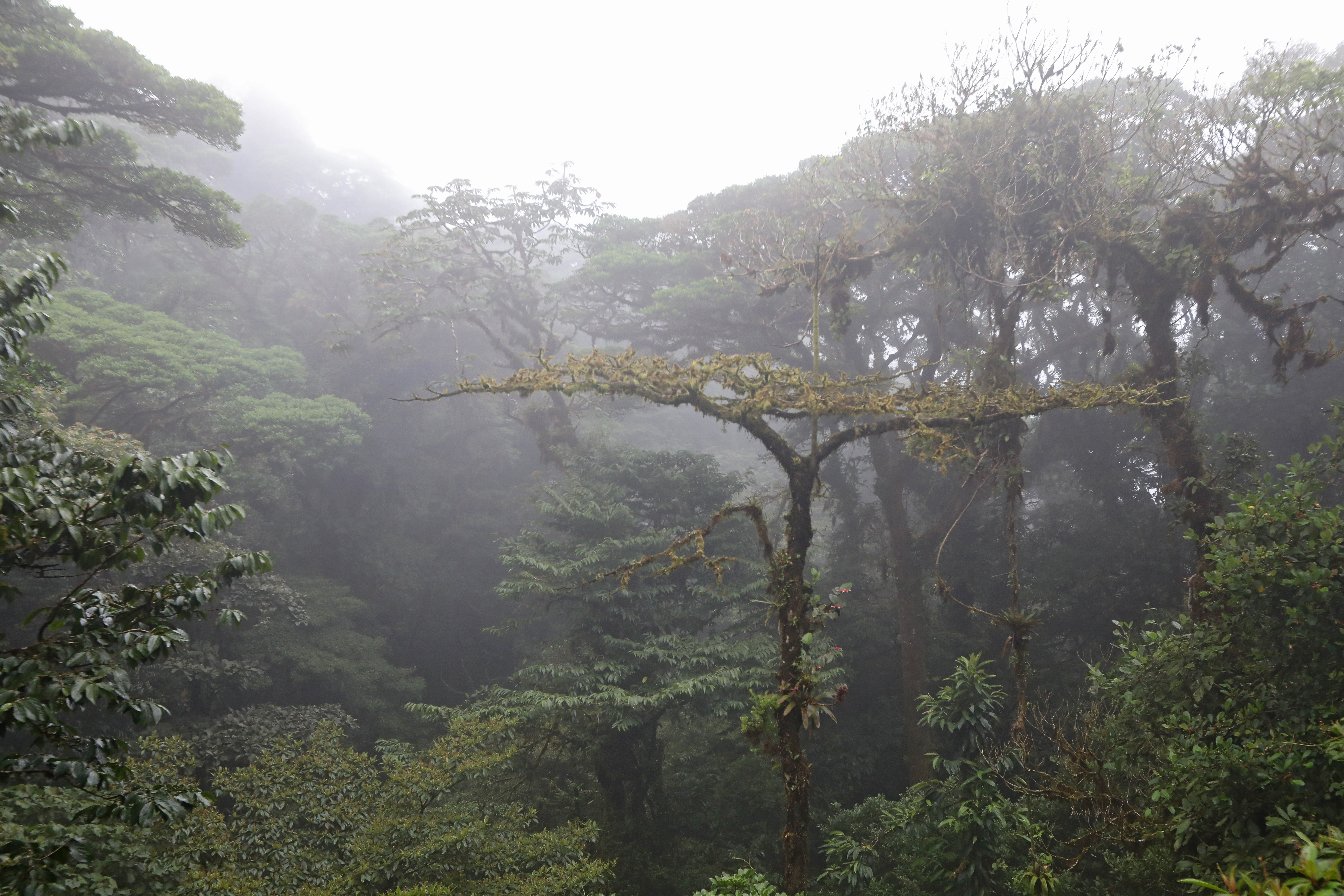
Your Journey to the Cloud Forest: A 2025 Monteverde Transport Blueprint
Getting to Monteverde can feel like the first great challenge of a Costa Rican adventure. Perched at a cool 4,600 feet (1,400 meters) above sea level, this ethereal cloud forest destination doesn't appear on the map as a simple point-to-point journey. The remote location and winding mountain roads often leave even seasoned travelers asking the same fundamental question: "How exactly do I get there?".1 This initial hurdle is a common experience, born from the very geography that makes Monteverde so magical. There is no airport, no train station, and no single, straightforward highway leading to its doorstep.
This feeling of uncertainty, however, is the only difficult part of the journey. Thousands of travelers successfully navigate these routes every year, and with the right information, the process can be smooth, stress-free, and even a scenic highlight of a trip. This comprehensive guide is designed to be the definitive resource for 2025, eliminating the guesswork and anxiety from transportation planning. It provides an honest, detailed breakdown of every available option from Costa Rica's two primary hubs, San José and La Fortuna.
Within this guide, one will find realistic travel times, up-to-date cost analyses for every budget, and a transparent look at what the road conditions are really like today, not five years ago. By the end of this blueprint, travelers will have the clarity and confidence to select the perfect mode of transport for their specific style, budget, and group size. This allows the focus to shift from logistics to the exhilarating anticipation of ziplining through the canopy, walking across misty hanging bridges, and discovering the incredible biodiversity that awaits in the clouds.
Monteverde Transport at a Glance: Comparing Your 2025 Options
For travelers in the planning phase, understanding the core trade-offs between cost, time, and convenience is paramount. The "best" way to get to Monteverde is entirely subjective, depending on whether the priority is the budget-conscious adventure of a public bus, the door-to-door ease of a shuttle, or the complete autonomy of a rental car. This table provides a high-level comparison to help guide decision-making before diving into the granular details of each option.
| Origin | Method | Avg. Cost (per Person) | Avg. Travel Time | Best For |
|---|---|---|---|---|
| San José | Shared Shuttle | $50 - $69 | 3.5 - 4.5 hours | Solo Travelers, Couples, Convenience Seekers |
| San José | Private Shuttle | ~$50 (group of 4) | 3 - 4 hours | Families, Groups, Schedule Flexibility |
| San José | Rental Car | $45 - $75+ (daily) | 3 - 4 hours | Maximum Flexibility, Independent Explorers |
| San José | Public Bus | $7 - $9 | 4.5 - 5.5 hours | Budget Backpackers, Authentic Experience |
| La Fortuna | Jeep-Boat-Jeep | $30 - $55 | 2.5 - 3.5 hours | Scenic & Efficient Travel, The "Classic" Route |
| La Fortuna | Shuttle (Road) | $40 - $55 | 3 - 4 hours | Directness, Comfort, Avoiding Boat Transfer |
| La Fortuna | Rental Car | $45 - $75+ (daily) | 3 - 4 hours | Explorers with Stops Planned |
| La Fortuna | Public Bus | ~$10 | 5 - 8 hours | Adventurous Budget Travelers, Patient Planners |
The data presented here is a synthesis of current 2025 pricing and timing estimates from a range of local operators and booking platforms.3 A traveler can immediately see, for example, that while the public bus from San José is exceptionally cheap, it comes with a significant time cost compared to a shuttle.3 Similarly, the "Jeep-Boat-Jeep" from La Fortuna stands out not just for its speed but for its unique, scenic approach, offering more than just a simple transfer.6 This framework allows a traveler to quickly identify the one or two options that best align with their personal travel philosophy and proceed to the detailed sections below for execution.
The San José Route: Your Path from the Capital to the Clouds
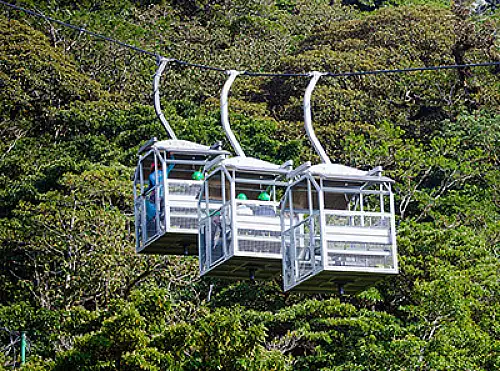
As Costa Rica's primary international gateway, Juan Santamaría International Airport (SJO) near San José is the starting point for many journeys to Monteverde. The 140-kilometer (87-mile) trip can be approached in several ways, each offering a distinct experience.11
Shared & Private Shuttles: The Gold Standard of Convenience
For the majority of travelers, shuttle services represent the optimal balance of cost, comfort, and efficiency. These door-to-door services eliminate the stress of navigating foreign roads or public transit systems, allowing passengers to relax and enjoy the scenic ascent into the mountains.3
Shared Shuttles
Shared shuttles are the most popular transportation method for good reason. They are typically modern, air-conditioned vans that accommodate 8-15 passengers and operate on a fixed daily schedule.3 This option is particularly well-suited for solo travelers and couples who value convenience but want to maintain a reasonable budget.3
Providers & Reputation: Several highly reputable companies service this route, ensuring a professional and reliable experience.
- Interbus, a leader in Costa Rican shuttle transport since 1996, is known for its extensive network and commitment to quality, even offsetting 100% of its carbon emissions.14
- Gray Line, a global sightseeing brand, offers robust DMC (Destination Management Company) services, including countrywide shuttles with a high standard of professionalism.17
- Monkey Ride is another trusted local operator known for its excellent customer service and reliability.20
2025 Pricing: For a one-way trip from the San José area to Monteverde, travelers should expect to pay between $50 and $69 USD per person.3 Prices can fluctuate based on seasonality and demand, so booking in advance is always recommended.3
Schedule & Duration: Most companies offer two departures daily, typically one in the morning around 8:00 AM and another in the afternoon around 2:30 PM or 3:00 PM.11 The journey takes approximately 3.5 to 4.5 hours, which includes a 15-20 minute rest stop for snacks and restrooms.3
Booking Advice: It is highly advisable to book shuttle services at least 24-48 hours in advance, particularly during the peak tourist season from December to April and again in July and August. Seats can and do sell out.23
Private Shuttles
While often perceived as a luxury, a private shuttle is the most convenient and flexible option available. For families and small groups, it can also be the most economically sound choice. The pricing structure for private shuttles is per vehicle, not per person, which creates a critical value inflection point.
Value Proposition: A private shuttle from San José to Monteverde typically costs between $180 and $220 USD for a vehicle that can hold up to 6-8 passengers.3 A group of four travelers would pay approximately $216-$276 for shared shuttle tickets ($54-$69 each). In this scenario, the private shuttle is not only more comfortable and convenient but is also objectively cheaper.3
Benefits: The advantages are significant. Travelers can dictate their own departure time, making it ideal for those with awkwardly timed flights. The journey can be customized with stops for photos at scenic overlooks, a visit to the famous "crocodile bridge" on the Tárcoles River, or an impromptu coffee break.3 This option is especially beneficial for those traveling with young children, seniors, or excess luggage like surfboards or camera equipment.23
The Experience: Beyond logistics, a private shuttle often includes an English-speaking driver who can serve as an informal guide, offering insights into Costa Rican culture, history, and the passing landscape, transforming a simple transfer into an enriching part of the travel experience.
Renting a Car: The Ultimate Freedom to Explore Costa Rica
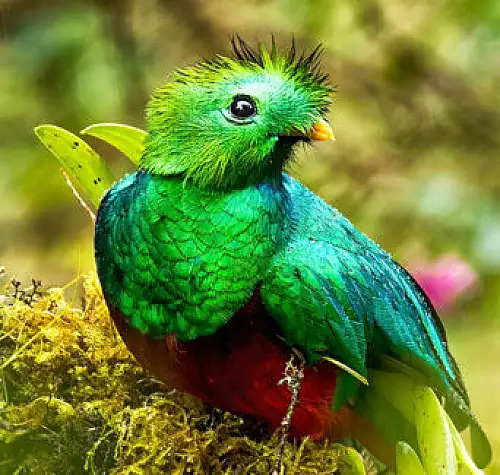
For the independent explorer, renting a car offers unparalleled freedom. It transforms the journey from a simple transfer into an integral part of the adventure, opening up possibilities for spontaneous detours to artisan towns like Sarchí or roadside sodas for a traditional meal.13
The Strategic Angle: Having a vehicle provides flexibility not only for the trip to Monteverde but also for exploring the region upon arrival. The various reserves, adventure parks, and restaurants in the Monteverde area are spread out, and a car makes it significantly easier to move between them without relying on taxis or tour-specific transport.1
2025 Cost Analysis: Budgeting for a rental car in Costa Rica requires looking beyond the advertised daily rate.
- Base Rental: In 2025, daily rates for an economy sedan can start as low as $25-$35, while a 4x4 SUV will typically range from $45 to $75 per day, before insurance and fees.24 While some aggregators may show rates as low as $6 per day, these are often misleading as they exclude mandatory fees.24
- Mandatory Insurance: Costa Rican law requires all drivers to have Liability Protection (LP), which covers damages to third parties. This is non-negotiable and will be added to the rental cost, typically ranging from $10-$30 per day.25 Collision Damage Waivers (CDW) may be covered by certain credit cards, but it is essential to have proof of this coverage in writing.26
- Total Cost: A realistic budget must include the daily rate, mandatory insurance, gas (which costs around $4.90 USD per gallon as of 2025), and any potential tolls.25
The Route: The most direct and improved route from San José is to take Highway 27 west, then connect to the Inter-American Highway (Route 1) north, before turning right onto Route 606 at Sardinal for the final ascent to Monteverde.3 The drive typically takes 3 to 4 hours without significant traffic or stops.3
Internal Link: The most critical factor for any driver is the state of the roads. For a detailed analysis of road surfaces, safety considerations, and the 4x4 debate, see our expert analysis in Section V: Driving to Monteverde in 2025.
The Direct Public Bus: An Authentic & Budget-Friendly Adventure
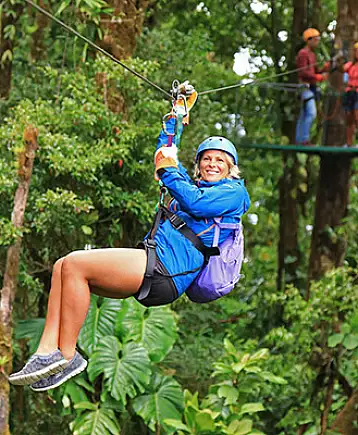
For the budget-conscious traveler or those seeking a more authentic local experience, the public bus is an excellent and reliable option. It requires more patience and planning but offers a unique glimpse into the daily life of Costa Ricans at an unbeatable price.3
The Operator: The direct service between San José and Monteverde is operated by the company Transmonteverde.11
The Terminal: Buses depart from Terminal 7-10 in downtown San José. This is a modern, multi-level terminal with shops and services.28 However, it is located in an area where travelers should be particularly mindful of their belongings.11
2025 Schedule & Cost: The schedule is consistent and easy to remember, with two departures daily: 6:30 AM and 2:30 PM.3 A one-way ticket costs approximately $7-$9 USD (around ₡3,885 Colones), making it by far the most affordable option.9
Travel Time & Experience: The journey takes between 4.5 and 5.5 hours.3 The longer duration is due to multiple stops along the route to pick up and drop off local passengers, as well as a slower pace on the final mountainous stretch. The afternoon bus is often slower due to heavier traffic leaving the city.3 Travelers should be prepared for a non-luxury experience; buses can be crowded, and air conditioning is not always guaranteed. Those prone to motion sickness should take precautions for the winding mountain roads.
Booking: During the high season, it is wise to arrive at the terminal 30-45 minutes early to secure a seat. In a significant improvement over past years, tickets can now be purchased in advance online through the Transmonteverde website, which is highly recommended to guarantee a spot.3
The La Fortuna Route: Volcano Views to Cloud Forest Canopies
The journey between La Fortuna, home of the Arenal Volcano, and Monteverde is one of the most popular travel legs in Costa Rica. Though geographically close "as the crow flies," the rugged terrain and massive Lake Arenal separate the two destinations, making the transport method a key part of the experience.6
The "Jeep-Boat-Jeep": The Essential Monteverde Scenic Shortcut
This uniquely Costa Rican mode of transport is the fastest, most scenic, and most recommended way to travel between La Fortuna and Monteverde.4 It cleverly turns the geographical obstacle of Lake Arenal into the journey's main attraction.
Demystifying the Name: The first thing to know is that the names "Jeep-Boat-Jeep" or "Taxi-Boat-Taxi" are colloquialisms. The land portions of the journey are not conducted in jeeps but in comfortable, modern, air-conditioned vans or minibuses.4 This clarification is important for managing traveler expectations.
The Process Explained: The trip is a seamless, three-step process organized by a single tour operator:
- Van Pickup: A van provides door-to-door service, picking travelers up directly from their hotel in La Fortuna for a 20-30 minute drive to the Arenal Lake dam.5
- Scenic Boat Crossing: At the dam, passengers board a covered boat for a picturesque 30-40 minute journey across the expansive Lake Arenal. This leg of the trip offers spectacular, unobstructed views of the Arenal Volcano and the surrounding forested mountains, effectively turning a transfer into a scenic tour.5
- Van to Monteverde: Upon arrival at the Río Chiquito dock on the other side of the lake, another van is waiting to take passengers on the final 1.5-hour drive up the mountain roads to their hotel in Monteverde.5
2025 Pricing & Duration: The entire door-to-door journey costs between $30 and $55 USD per person and takes a total of 2.5 to 3.5 hours.4 This makes it significantly faster than driving the entire way around the lake.6
Why It's Recommended: This method has become the default choice for most travelers because it perfectly balances efficiency, cost, and experience. It is less stressful than driving oneself and transforms a potentially arduous travel day into a memorable and enjoyable part of the Costa Rican adventure.4
Driving Around the Lake: Shuttles & Rental Cars
For those who prefer to stay on solid ground or have a vehicle for further exploration, driving the road around the lake is a viable, albeit longer, alternative.
Shared Shuttles (Road Only)

Direct, road-only shared shuttles offer a comfortable and straightforward option. These services will pick up at a hotel in La Fortuna and drive the entire route to Monteverde without the need to transfer to a boat.
Cost & Time: The price is comparable to shared shuttles from San José, typically ranging from $40 to $55 per person.5 The travel time is approximately 3 to 4 hours, depending on road conditions and stops.4
Consideration: A crucial insider tip is to be aware that some shuttle companies may cancel a scheduled trip at the last minute if they do not have enough passengers to make the route profitable. It is always wise to have a backup plan in mind when booking this option.5
Rental Cars
Driving from La Fortuna to Monteverde provides the ultimate flexibility to stop and admire the incredible scenery along the way.
The Route: The drive follows Route 142, which winds along the northern shore of Lake Arenal, offering beautiful views. Upon reaching the town of Tilaran, drivers will turn onto Route 145, which eventually becomes Route 606 for the final ascent to Monteverde.5
Flexibility: This option allows for detours to attractions like the Viento Fresco Waterfalls just past Tilaran, or simply pulling over at one of the many scenic viewpoints overlooking the lake and volcano.5
Internal Link: The road conditions on the final stretch from Tilaran are a mix of paved and unpaved sections. For a comprehensive breakdown of what to expect, please refer to Section V.
The Backpacker's Path: Navigating the Public Bus via Tilaran
Traveling from La Fortuna to Monteverde by public bus is the quintessential backpacker's challenge: it is the most affordable route but also the most complex and time-consuming, requiring precise coordination.4
Setting Expectations: There is no direct bus service. The journey requires a transfer in the town of Tilaran and can take anywhere from 5 to 8 hours from start to finish, depending heavily on the connection time.4
- Step 1: La Fortuna to Tilaran:
The first leg involves taking a bus operated by Transpisa from the main terminal in La Fortuna to Tilaran.32
Schedule: Departures are typically offered three times a day, around 8:00 AM, 12:15 PM, and 5:30 PM.5
Cost & Duration: The ride costs approximately $7 USD and takes about 1.5 to 2 hours.5 - Step 2: Transfer in Tilaran:
Upon arrival in Tilaran, travelers must wait for the connecting bus to Monteverde. The length of this layover is the most variable part of the journey. - Step 3: Tilaran to Monteverde (Santa Elena):
The bus from Tilaran to Monteverde generally departs once a day around 12:30 PM.28
Cost & Duration: This final leg costs only $1.50 to $3 USD and takes another 1.5 to 2.5 hours, navigating the bumpy mountain roads.5
Expert Tip: The entire feasibility of this route hinges on making the connection in Tilaran. To do this successfully, it is imperative to take the 8:00 AM bus from La Fortuna. This arrival time aligns perfectly with the 12:30 PM departure to Monteverde, allowing time for a break. Missing this connection could result in being stranded in Tilaran for the day.5
Driving to Monteverde in 2025: A Realistic Guide to Road Conditions
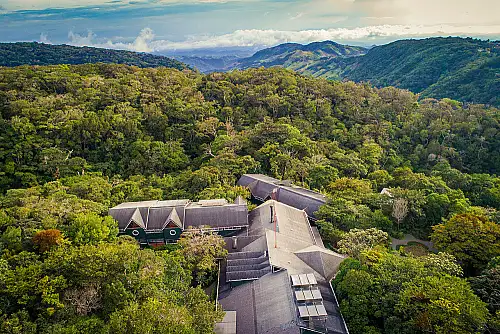
The question of road conditions is, without a doubt, the most common concern for independent travelers planning a trip to Monteverde. Stories from years past paint a picture of treacherous, impassable tracks, but the reality in 2025 is far more nuanced. Significant infrastructure improvements have changed the landscape, yet the region's mountainous terrain and tropical climate mean that preparation and the right vehicle are still key.
Are the Roads to Monteverde Bad? The Paved & Unpaved Reality
The simple answer is that the main routes are no longer the "bad" roads of legend, but they still demand respect and cautious driving.
The Good News: The Costa Rican government has invested heavily in paving the primary arteries to this crucial tourist destination. The days of needing a 4x4 for the main highway approach are largely over, especially in the dry season.37
Route 606 (from San José/Inter-American Highway): This is the most significant improvement. As of recent updates, Route 606 is almost entirely paved with asphalt or concrete from the turnoff at the Rancho Grande gas station on Route 1 all the way to the town center of Santa Elena.27 The road is still very curvy, steep in sections, and lacks guardrails and streetlights, but the surface itself is smooth for most of the journey.37
Route 145/606 (from La Fortuna/Tilaran): This route remains a different story. While the scenic drive around Lake Arenal on Route 142 is fully paved, the final 35-kilometer stretch after Tilaran is a challenging mix of surfaces. Drivers will encounter sections of rough gravel, bumpy dirt, and some patches of pavement.5 It is hilly, slow-going, and features larger rocks and potholes that require careful navigation.37
Why a 4x4 is Still Your Best Bet (Even on Paved Roads)
Despite the paving of Route 606, a high-clearance SUV, preferably with 4x4 capability, remains the strong recommendation for any trip to Monteverde. The reasoning extends beyond the main road surface and considers the holistic nature of traveling in this unique environment.
- The Rainy Season (May - November): This is the most critical factor. During the "green season," intense tropical downpours are a daily occurrence. These rains can make even paved roads slick and treacherous. On the gravel sections of the Tilaran route, the road can quickly become muddy and rutted.37 Small landslides or washouts, while usually cleared quickly, are a possibility. A 4x4 provides essential traction and a higher degree of safety in these conditions.37
- Steep Inclines & Engine Power: The journey to Monteverde is a constant climb. The roads feature long, steep grades that can put significant strain on a small sedan engine, especially when carrying multiple passengers and luggage. An SUV with a more powerful engine can handle these inclines with greater ease and less stress on the vehicle.
- Ground Clearance is Key: Perhaps more important than four-wheel drive is high ground clearance. The roads, both paved and unpaved, can have significant potholes, unmarked speed bumps (topes), and uneven surfaces. A standard sedan is at risk of "bottoming out," potentially causing serious damage to the undercarriage. The higher clearance of an SUV provides peace of mind and a much smoother, less jarring ride.38
- Access to Hotels, Reserves & Attractions: This is the "last mile" problem. While the main road into town may be paved, many hotels, eco-lodges, and adventure parks are situated on secondary roads that are unpaved, steep, and poorly maintained. Without a high-clearance vehicle or 4x4, travelers may find it difficult or impossible to reach their final destination, especially after a rainstorm.
Essential Driving Tips for a Safe & Scenic Journey
Drive During Daylight: This is the single most important piece of advice. It is strongly recommended to plan your drive to arrive in Monteverde well before sunset (around 6:00 PM year-round). The mountain roads have very few, if any, streetlights or guardrails. Add the potential for dense, disorienting fog that can roll in quickly in the afternoons, and night driving becomes genuinely hazardous.13
Navigation: Waze is the preferred navigation app in Costa Rica, followed by Google Maps.39 However, cell service is notoriously unreliable and often nonexistent in the mountains. It is absolutely essential to download offline maps of the entire region to your device before you depart from San José or La Fortuna.
Pace & Etiquette: Adopt the "Pura Vida" mindset and drive slowly. The roads are winding, and visibility can be limited around sharp curves. Local drivers may travel at a faster pace; do not feel pressured to keep up. If a line of cars forms behind you, find a safe, straight stretch of road to pull over and let them pass.
Fuel: Gas stations become sparse as you begin the ascent into the mountains. Be sure to fill up your tank in a larger town like San Ramón, Sardinal, or Tilaran before heading up the final stretch to Monteverde.
Frequently Asked Questions (FAQ) about Getting to Monteverde
This section addresses the most common logistical questions to provide quick, clear answers for travelers.
Q1: Is there an airport in Monteverde?
No, there is no airport or airstrip in Monteverde. The high altitude and mountainous terrain make it impossible to construct one. The two main international airports that serve as gateways to the region are Juan Santamaría International Airport (SJO) near San José and Daniel Oduber Quirós International Airport (LIR) in Guanacaste/Liberia. From SJO, the drive is about 3.5 hours, and from LIR, it is about 2.5 hours.40 While there are small domestic airports in nearby areas like La Fortuna (FON), flying is not a practical or time-saving option for reaching Monteverde, as it still requires a lengthy and expensive ground transfer.41
Q2: Can I take an Uber or Taxi to Monteverde?
While it is technically possible to find an Uber or taxi in San José willing to make the trip, it is not a recommended or reliable method. The cost would be very high, likely in the range of $100-$150 USD or more, and many drivers would be hesitant to take the fare due to the long, one-way return trip on challenging roads.13 For a private, direct transfer, booking a dedicated private shuttle service in advance is a far more reliable, comfortable, and often more cost-effective solution.3
Q3: How far in advance should I book my transportation?
During the peak tourist seasons (mid-December through April, and July through August), it is highly recommended to book transportation at least 48-72 hours in advance. Shared shuttles are particularly prone to selling out during these times.23 For rental cars during the absolute peak weeks of Christmas, New Year's, and Easter (Semana Santa), it is best to book several months in advance to secure a vehicle and a reasonable rate. During the low season (May, June, September, October, November), booking 24 hours in advance is often sufficient for shuttles.
Q4: What is the best time of day to travel to Monteverde?
Morning departures are unequivocally the best choice for any mode of transportation. Traveling in the morning allows you to avoid the heavy afternoon traffic that often builds up around the San José metropolitan area. Most importantly, it ensures you will be navigating the final, winding mountain roads in full daylight, with the best possible visibility. In the rainy season, afternoon downpours and thick fog are common in the mountains, making a morning journey much safer and more pleasant.
Q5: What should I pack for the journey itself?
Regardless of how you travel, it's wise to be prepared. Pack layers of clothing; the temperature in Monteverde can be 10-15°F (5-8°C) cooler than in the lowlands of San José or La Fortuna. If you are sensitive to motion sickness, medication is highly recommended for the winding roads. Always carry water and snacks, especially for longer journeys like the public bus where stops are infrequent. Finally, have a portable power bank to keep your phone charged for navigation and photos, and keep your booking confirmations easily accessible.
Q6: Is it safe to travel to Monteverde?
Yes, traveling to Monteverde is very safe. The shuttle and bus companies that service the routes are professional, licensed, and have decades of experience navigating the local roads.3 The primary safety considerations fall on those who choose to drive themselves. By following the essential driving tips—traveling only during daylight hours, driving slowly and defensively, and being prepared with offline maps—the journey is perfectly safe and enjoyable.13
Your Adventure Awaits: From Seamless Travel to Unforgettable Tours
The journey to Monteverde, once a daunting prospect, is now an accessible and exciting part of any Costa Rican itinerary. By choosing the option that best fits a personal travel style—be it the door-to-door convenience of a shuttle, the boundless freedom of a rental car, or the authentic adventure of the public bus—the logistical challenges dissolve, replaced by anticipation.
Now that the path to the cloud forest is clear, the focus can shift to the incredible experiences in it. Planning the journey is just the first step; immersing oneself in the magic of the forest is the true destination. This is where local expertise transforms a great trip into an unforgettable one.
Our Combo Tours are designed with the modern traveler in mind, maximizing time and value by packaging Monteverde's must-do activities. These curated experiences combine the adrenaline of soaring through the canopy on a zipline with the serene wonder of a hanging bridges walk, or pair the rich aromas of a coffee plantation tour with the mysterious world of a guided night hike. This strategic angle ensures a comprehensive and efficient exploration of the region's diverse offerings.
Our value proposition is rooted in authenticity and deep expert knowledge. Our guides are not just tour leaders; they are local naturalists, passionate storytellers who can spot a Resplendent Quetzal hidden in the foliage or explain the intricate life cycle of a glass frog. They transform a simple walk into a profound connection with one of the world's most unique ecosystems.
Above all, a traveler's comfort and safety are the cornerstones of every tour. From meticulously maintained, state-of-the-art zipline equipment to small group sizes that allow for personalized attention, every detail is managed so that one can focus entirely on the beauty and thrill of the moment.
Your Monteverde adventure starts here. Don't just visit the cloud forest—experience its heart and soul with those who know it best.
 Browse All
Browse All
